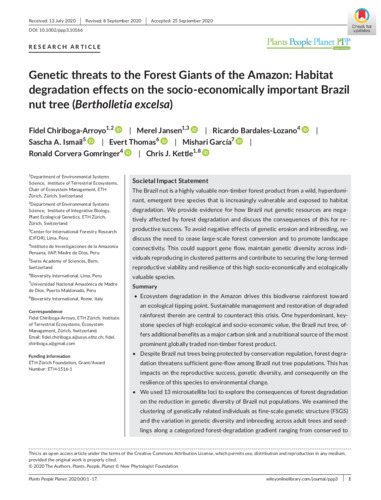Genetic threats to the forest giants of the Amazon: Habitat degradation effects on the socio-economically important Brazil nut tree (Bertholletia excelsa)
Ecosystem degradation in the Amazon drives this biodiverse rainforest toward an ecological tipping point. Sustainable management and restoration of degraded rainforest therein are central to counteract this crisis. One hyperdominant, keystone species of high ecological and socio-economic value, the Brazil nut tree, offers additional benefits as a major carbon sink and a nutritional source of the most prominent globally traded non-timber forest product.
• Despite Brazil nut trees being protected by conservation regulation, forest degradation threatens sufficient gene-flow among Brazil nut tree populations. This has impacts on the reproductive success, genetic diversity, and consequently on the resilience of this species to environmental change.
• We used 13 microsatellite loci to explore the consequences of forest degradation on the reduction in genetic diversity of Brazil nut populations. We examined the clustering of genetically related individuals as fine-scale genetic structure (FSGS)
and the variation in genetic diversity and inbreeding across adult trees and seedlings along a categorized forest-degradation gradient ranging from conserved to degraded areas. In addition, we applied direct and indirect approaches to estimate
contemporary pollen-mediated gene flow.
• We found significant levels of FSGS, comparable to other similar tropical tree species. Brazil nut seedlings had consistently lower genetic diversity and higher inbreeding than adults, significantly associated with the degree of forest degradation of their origin. We observed limited pollen dispersal, differential patterns in pollen heterogeneity, and disproportionate paternal-assignment rates from few individuals shaping the effective population size in our dataset. We discuss how this evidence for reproduction vulnerability may affect the genetic resources and undermine the resilience of this ecological and socio-economic system in Peru.

